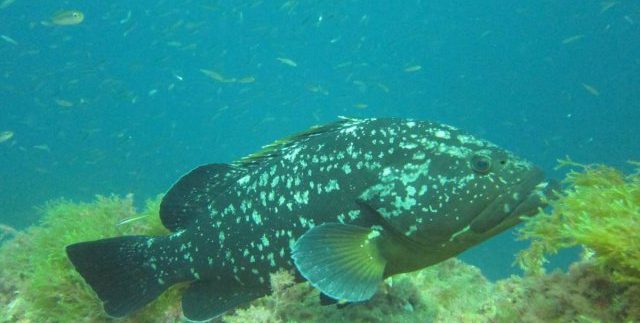Scuba Diving: Cabo de Palos

The Cabo de Palos marine reserve is a well established breeding ground for Mediterranean fish and wildlife , it is highly protected by th
Marine authorities since 1995 and is home to an abundance of marine life such as huge Groupers, shoals of Barracuda, Octopus, Moray eels, Eagle rays as well as Nudibranch and the occasional Sunfish.
This area is considered the Best place to dive in Spain and one of the Top areas in Europe for marine life abundance and this is because it is situated in open sea with nutrient rich waters hitting the dive sites that brings fish to this special area, but the marine park is vulnerable to waves and currents so its always advised that you have dived recently, have some experience of diving in currents and are in good shape.
During later September and early October the marine life is at its most active due to the small fry fish shoals such as sardines and bogas which are
small fish growing bigger and bigger congregating around the underwater reefs inside the park and also the shore .
This abundance of life attracts the predatory fish such as denton, barracuda, jacks, dorada , tuna and even the colourful mahimahi or otherwise known as dolphinfish gather to have a feeding frenzy which creates a bait ball effect which is spectacular to watch and one of the areas most special events within the Mediterranean waters.
This can go on for weeks with different marine creatures swimming hard and fast into the shoal to grab a quick bite that makes the smaller shoaling fish swim closer together and erratically making the bait ball
effect and creating a large silver ball of fish that looks spectacular and attracts hundreds of divers with cameras and videos.
Due to the area’s history we have many different and exciting wrecks, some are still very much intact to the occasion object being found such as an ancient
anchor or amphora’s being overturned in a storm that have been lying hidden for hundreds if not thousands of years.
There was recently a Phoenician wreckfrom 600BC discovered in a small reef called La Laja and la campana north east off of isla grosa island. Due to its age there was not much of the boat remaining as it was made ostly of wood,but there is plenty of pottery and spear heads found which lead to a more extensive excavation which was productive and 2 elephant tusks were recovered that dated back nearly 2,500 years.
This makes diving much more fun and interesting in this area as you never know what you could find under the surface.
Some of the wrecks that are regularly dived are the(lsla Gomera) which sank in a violent storm in 1946 just out of the port of cabo de palos. It was carrying a cargo of oranges which lead to the ship being nicknamed the “Naranjito” which divers will be more familiar with. The wreck is 50 metres long and lies at a depth of 28m at the bow and 43m to the propeller.
The Turia and Ulla which are wooden minesweepers were sunk by the navy between Isla Grosa and Cabo de Palos for training purposes and lie in approximately 28 to 35m deep.
El vapour or “Sama” which is an old wreck at 50 meters deep and has not been explored much due to the depth and is broken down and flattened due to its age but has many large nudibranches (hypseldoris picta) living on it.
An off shore reef called Bajo de Fuera within the “Islas Hormigas marine park” has been a fatal shipping trap due to its distance from shore and being outside of the Islas Hormaigas islands lighthouse and a huge reef system that peaks at just 3 metres below has a known 4 ship wrecks lying at the base of the reef. One was the famous Sirio passenger liner which hit the reef in 1908 and was carrying approximately 1000 immigrants from Italy when it struck the shallow reef and grounded for days until a storm broke the ship in two, the bow section slipping to the south side of the reef and the stern slipping into the north.
Article spnsored by Adventure Divers

 Spanish
Spanish German
German Dutch
Dutch